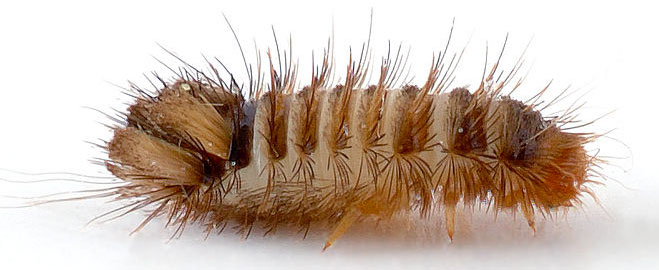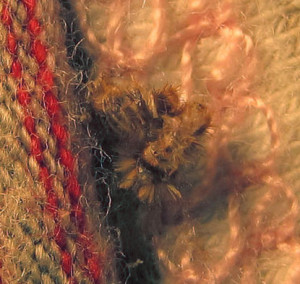What Does Carpet Beetle Damage Look Like?
By Chris Williams on January 5, 2015.

Carpet beetles and clothes moths are our two main fabric pests. The damage that they leave in woolens, other fabrics, hides, and furs can look similar but there are some other clues that they leave behind that will tell you which pest is the culprit.
While adult carpet beetles are often seen wandering around a home, they are tiny and often overlooked. Carpet beetle larvae (the stage that does the damage) remain hidden away in, or under, the material that they are feeding on and are usually not noticed either without a full inspection (see Meet the Carpet Beetles). What is noticed eventually are small holes in wool sweaters, blazers, blankets, etc. or damage to rugs or furs.
Here’s What You’re Looking For
Carpet beetle larvae are yellow-brown, about ¼ inch long, and covered with bristly hairs. They have short legs and can move, but they avoid light and remain hidden.
Carpet beetle larvae feed on the surface of fabrics, sometimes just removing the nap. In other cases, they will clip fibers, leaving irregular holes or small open spaces in the weave. In a large infestation, the feeding holes could run together, leaving a larger damaged area. Carpet beetle larvae prefer to feed on woolens and fabrics that are soiled by food spills, perspiration, urine, etc. (see Why Do Fabric Pests Prefer to Dine on Dirty Clothes?). They will also damage cotton, silk, and linen, especially if soiled.
In wool or wool blend rugs, carpet beetle larvae tend to eat slits in the material. To find the larvae, look at the bottom side of the rug. On furs, hides, natural bristle brushes, or even mounted trophies, carpet beetle larvae clip the hairs off, eventually resulting in a bald spot but not damaging the hide beneath. Look for hairs on the floor below.
Shed Larval Skins Are a Carpet Beetle Clue
I said earlier that clothes moths leave similar damage. If you can find the insects, you know who is causing the damage. But you may find only evidence that the insects were there. The best way to tell carpet beetle damage from clothes moth damage is to look for shed skins left behind by carpet beetle larvae.
The larvae have to molt several times in order to grow. Their old skins split down the back (much like a cicada nymph’s shell) and the larvae work their way out. The empty skin remains in the shape of the larva, is yellow or light brown, and is dry and crispy. In a heavy carpet beetle infestation, you should find many shed skins in areas where the larvae are feeding. These are easier to find if you are talking about an infested carpet or woolens stored in a box; harder to find skins when there is random damage to hanging clothes.
Silk Threads Mixed in Means Clothes Moths Instead
There is one other way to tell whether the damage is from carpet beetles or clothes moths. Clothes moth larvae don’t leave noticeable shed skins but they do leave silken webbing over the material on which they are feeding. Depending on the type of clothes moth, you may find silk webbing on the underside of the material, or you may find silken tubes or cases attached to the material that serve as shelters for the larvae. Carpet beetles don’t spin silk. In some situations, you may find both kinds of fabric pests infesting the same material.
By André Karwath aka Aka (Own work) [CC BY-SA 2.5], via Wikimedia Commons
Photo credit: carpet.beetle / IWoman / CC BY
Stay up-to-date with Colonial Pest’s email newsletter!
